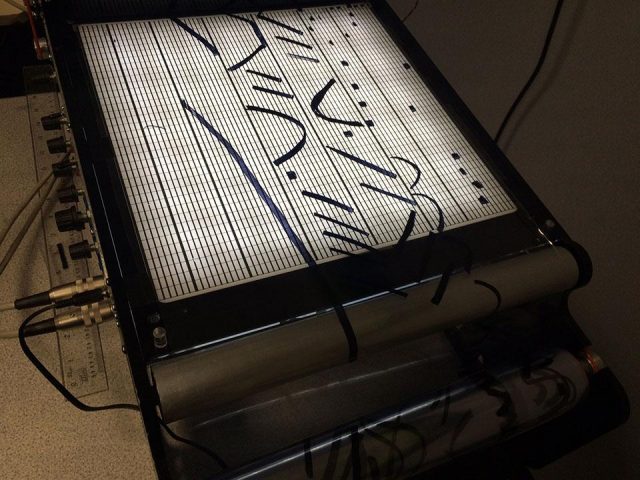
In the 1960’s, electronic music pioneer Daphne Oram, above, the first Director of the BBC Radiophonic Workshop, created a unique synthesizer, the Oramics Machine.
The Oramics Machine was a huge device, which moved film strips past a series of photo-electric cells. The Machine translated the graphics drawn on the film into control voltages that modulated the amplitude, timbre, frequency and duration of synthesized sound.
It wasn’t designed for playing traditional music – but to create a gestural and visual approach to synthesizing sound.
The original Oramics Machine, above, was huge. So, in the 70’s, Oram designed the Mini-Oramics, but a prototype was never made. Now, 40 years later, PhD student Tom Richards has not only researched Oram’s ‘lost’ synth design, but he has has built a working prototype.

“The rules were simple,” notes Richards. “I had to imagine I was building the machine in 1973, interpreting Daphne Oram’s plans and using only the technologies that existed at that time.”
Here’s a video demo of the Mini-Oramics synthesizer in action:
Richards is now working with six contemporary composers, giving each of them a few days to play with the Mini-Oramics machine.
The video captures early experiments with Mini-Oramics from composers Ain Bailey, James Bulley and Jo Thomas.

Wasn’t Evgeny Murzin, creator of Russian ANS project, somewhat ahead of this as he did much the same thing back in 1938, with his final machine working in the 50’s?
http://createdigitalmusic.com/2013/10/ans-amazing-eerie-russian-optical-synth-now-ios-links-links-vids/
Yes and even other Russian composers earlier, in the 1930s, Yevgeny Sholpo and Nikolai Voinov, several videos here : https://www.youtube.com/watch?v=8EGFPZdiVqI&index=2&list=RDZ7Zb4rso82M
I never understood why so many people pretend that Oram invented this technique. She re-invented it, not knowing that it had been done before I guess and that doesn’t lower the quality of her work but she was not the first one. Some call it electronic music but it’s not, it’s synthetic music.
I don’t understand why either of you would feel compelled to make a straw man argument against Oram here.
First of all, if you knew anything about the ANS synthesizer, you’d know that these instruments are completely different designs. Their similarities are limited to the the fact that they both use photoelectric sensors. That’s like saying that a Buchla modular and a Moog modular are the same, because they both used transistors.
The ANS is a polyphonic synth that adds sine waves that are printed on discs, while the Oramics Machine is monophonic and directly synthesizes the sounds. Using your logic, you could argue that the ANS ripped off the tone wheel idea used in the Telharmonium, 50 years earlier.
In addition to being completely wrong about that, you’re complaining about people ‘pretending that Oram invented this technique’ in response to an article that doesn’t make any mention of her inventing anything.
It’s strange that you would feel compelled to blurt out random statements that minimize Oram’s work, when its appears that you only have a superficial understanding of it and the work of her predecessors.
The sad reality is that most of the pioneering electronic instruments were dead ends that made no real impact on either classical or electronic music.
Key exceptions would be the theremin, ondes martenot, and Buchla and Moog synthesizers.
music school throwdown watch out no knives no bottles unless using them for percussion or piano treatment
Yevgeny Sholpo and Nikolai Voinov. So I’m not speaking about the ANS.
I don’t care that they were men, women, trans, none, aliens, plants or whatever else.
And as I said : “that doesn’t lower the quality of her work”.
Percy Grainger’s free music also predates both of those things, doesn’t make either of them less interesting though…
The ANS is fully polyphonic and will generate all 720 pitches simultaneously!
Wow, a piano roll with automation curves ancestor.
sound remarkably like an ondes martenot . i want one please!!
interesting, waiting for the actual music
and not this tec demo
“Richards is now working with six contemporary composers, giving each of them a few days to play with the Mini-Oramics machine” It’ll come 😉
An iPad or device with a touch screen would be the perfect medium for a modern day replication of this. But, kudos to the doctoral student for building a physical prototype!
There are iPad versions of the Oramics Machine and the ANS:
https://itunes.apple.com/app/oramics/id454505541?ign-mpt=uo%3D8
https://itunes.apple.com/app/virtual-ans/id711384847?mt=8
I’d be interested in whether anyone with experience with either of the machines can comment how well or poorly the apps emulate them.
I love Daphne Oram’s work and this is a brilliant video. It sounds really organic, almost acoustic. Now I’ll have a better chance of working out when I’m actually hearing the Oramics machine in her music.